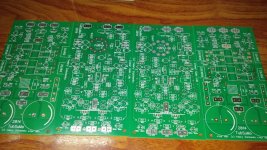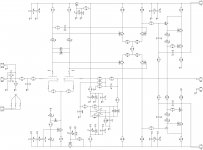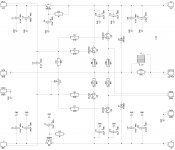To follow up on Valery's comments, there are some commonly accepted practices in amplifier design and one of them is to make the amplifier as linear as possible before any global feedback is applied. This means designing each individual stage for linear operation. One could argue that the input stage is the most important one because if it has high distortion then that distorted signal will be passed on to all succeeding stages. With enough global negative feedback, the signal might get cleaned up enough to look OK both in simulation and measurements, but that's poor design practice. Dropping a 6SN7 into the TubeSuMo without redesigning the input stage for that particular tube will give a poorly performing input stage, as Valery points out.
But this is DIY after all, so if this is the path you want to take then go for it.
But this is DIY after all, so if this is the path you want to take then go for it.
I think it's obvious from several posts now that one should stick with a 12AU7 only!
Rolling tubes certainly isn't near as easy as rolling say op-amps. In fact, I wouldn't even try it with there being so many parameters for tubes.
But as Ray stated, if someone thinks they can substitute a 6SN7 in place of a 12AU7 without making the necessary changes to the circuit, then by all means go for it.
Rolling tubes certainly isn't near as easy as rolling say op-amps. In fact, I wouldn't even try it with there being so many parameters for tubes.
But as Ray stated, if someone thinks they can substitute a 6SN7 in place of a 12AU7 without making the necessary changes to the circuit, then by all means go for it.
You missed the point
No I didn't, I am steering the conversation away from what other tubes can we use🙂
+1, especially do not trust the models at very low plate voltages - most of them are extremely inaccurate. Garbage in -> garbage out. 😉Don't trust everything you see in the simulator - some things are just not reflected in the model.
But atleast can we use 12AX7?
or I end up using a separate valve preamp
In general, with such low plate voltage as we have on this hybrid, you are limited to low-mu tubes (mu of something less than 20-25) because you want to have enough headroom before positive grid current occurs. 12AX7 is definitely not low-mu. It's one of the highest mu triodes with mu=100. Besides, it's notorious for grid current before even reaching positive grid voltage.
Your options vary from 12AU7, ECC99, 6SN7 or the perfectly fine Russian equivalent 6N6P or 6N8S. Check the datasheet and look for "amplification factor".
IMO, don't sweat getting expensive tubes. With due respect to Valery, this amp employs such high negative feedback, you won't be hearing any difference between different tube brands. It's unlikely you'll even hear the difference between FetSuMo, BipSuMo and TubSuMo! CMIIW
Yup, that about sums it up. The tube type and lifespan discussion are interesting but irrelevant, just do what the Chinese do, put some LED's to light up the tubes if you want to have that tubey look.It's unlikely you'll even hear the difference between FetSuMo, BipSuMo and TubSuMo! CMIIW
Gentlemen, I fully agree 🙂
This is roughly what I wrote in a private email - purpose of the tube in a differential input stage is totally different from the purpose in a common cathode cascade, where most of the tubes will have their own sonic "character". In a high-loop-gain front-end with differential cascade, this character will be strongly 'normalised" - you will most likely not recognise the sonic difference between the different small-signal tubes there (assuming each of them is set to the optimal working conditions). They will not sound "tubish" at all.
The purpose of the tube there is to provide a good combination of low noise, high linearity and good fast transients handling. Low-mu tubes are the most suitable for the purpose.
This is roughly what I wrote in a private email - purpose of the tube in a differential input stage is totally different from the purpose in a common cathode cascade, where most of the tubes will have their own sonic "character". In a high-loop-gain front-end with differential cascade, this character will be strongly 'normalised" - you will most likely not recognise the sonic difference between the different small-signal tubes there (assuming each of them is set to the optimal working conditions). They will not sound "tubish" at all.
The purpose of the tube there is to provide a good combination of low noise, high linearity and good fast transients handling. Low-mu tubes are the most suitable for the purpose.
But atleast can we use 12AX7?
You can if you want, but the 12AX7 in this circuit will also be biased in positive grid territory. This has been covered in several other posts, so at this point I'll bow out of the discussion. I don't think there is much more that can be said on this topic.
All right but I want to say that I have seen significant difference between Jfet input and the BJT input.
Regarding the tubes I agree the fact about the NFB and swomping out the tonality with the feedback.
Im sticking to the Preamp configuration than using the tube IPS.
Regarding the tubes I agree the fact about the NFB and swomping out the tonality with the feedback.
Im sticking to the Preamp configuration than using the tube IPS.
I am happy to report that I finished the FetSuMo IPS today and it works beautifully. Square waves look perfect and it sound lovely. I'm not sure if it sounds any different that the TubSuMo but it is very, very nice. I would still use speaker protection because it has a pretty big thump.
Terry, good to know  I have never live-tested this variant myself.
I have never live-tested this variant myself.
Can you please show the schematic with values you used for the build.
Thank you,
Valery
 I have never live-tested this variant myself.
I have never live-tested this variant myself.Can you please show the schematic with values you used for the build.
Thank you,
Valery
I used the schematic you posted in post #561
http://www.diyaudio.com/forums/atta...-rather-simple-hybrid-more-fetsumo-01-sch.jpg
http://www.diyaudio.com/forums/atta...-rather-simple-hybrid-more-fetsumo-01-sch.jpg
I am happy to report that I finished the FetSuMo IPS today and it works beautifully. Square waves look perfect and it sound lovely. I'm not sure if it sounds any different that the TubSuMo but it is very, very nice. I would still use speaker protection because it has a pretty big thump.
Just use dual relay for the OPS with delay of 1 or 2 sec and you get zero thump. Or use individual trafo for IPS and OPS use some dealy to trigger the OPS trafo.
simple way is to use diodes at the psu entry for the IPS+VAS stage will reduce the thump but not eliminate it.
Yes, I still recommend to always use protection with power-on delay, dealing with amplifiers, DC-coupled at the output - if we respect our speakers 😉
No thump + safe operation 😎
By the way, it's also easier for the amplifier to start with no load, until the offset zeroes-out.
No thump + safe operation 😎
By the way, it's also easier for the amplifier to start with no load, until the offset zeroes-out.
Dear Mr vzaichenko, I'm doing tubsumo 2014 version, please ask me for running voltage to + -70vdc. I have to change the resistor values do or I have to insert the correct value on the pcb
please help, thank you
Hi Diyminh,
I will publish the latest schematic with the values for +/-70V rails later today.
Cheers,
Valery
TubSuMo 2014 +/-70V rails FINAL
Here we go!
Please note - for the best noise performance, both 6.3V AC wires for the tube's heater must be connected to the main ground via 0.1uF capacitors (on PSU board or close to it).
Cheers,
Valery
Here we go!
Please note - for the best noise performance, both 6.3V AC wires for the tube's heater must be connected to the main ground via 0.1uF capacitors (on PSU board or close to it).
Cheers,
Valery
Attachments
- Home
- Amplifiers
- Solid State
- Ultra-high performance, yet rather simple - hybrid and more!


